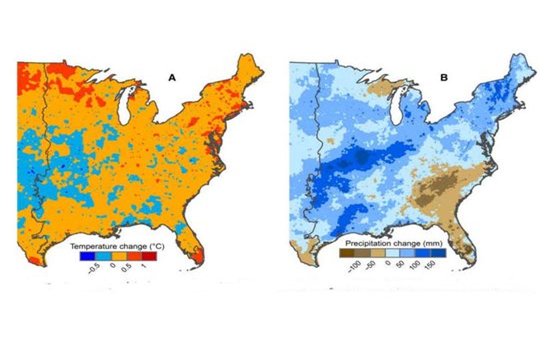
Fed Up With , Trees Are Moving North & West
USA TODAY – Doyle Rice – May 18, 2017
It’s getting so hot that even the trees are heading north. Man-made climate change — including warmer temperatures and deviations in rainfall patterns — appears to be one of the reasons tree populations in the eastern U.S. are shifting north and, more surprisingly, west, according to new research.
The shift could even lead to the extinction of certain trees in select forests, the study said.
Overall, the changing climate has pushed trees an average of 20 miles north and 25 miles west over the past 30 years. While the northern shift was expected due to warming temperatures, researchers think the more surprising westward movement could be the result of a change in rainfall patterns.
When researchers analyzed the impact of climate change, they found precipitation had a stronger impact on forests in the short term than temperatures, said lead author Songlin Fei of Purdue University.
The eastern U.S. has gotten warmer over the past few decades, and the Southeast has been trending drier.
Fei said that deciduous trees like oak and maple are primarily moving west, and evergreens are moving north. While trees don’t move, of course, where they sprout can change. Saplings can expand into a new region while older growth dies in another, The Atlantic reported.
Left: Changes in temperature across the eastern U.S. between the recent past (1951–1980) and the study period (1981–2014). Yellow and red areas have warmed, while blue areas have cooled. Right: Changes in precipitation. Blue areas have gotten wetter and brown areas have gotten drier.
One of the more striking examples is the scarlet oak, which in nearly three decades has moved more than 127 miles northwest from the Appalachians, Fei told the Associated Press. Today, its population is reduced in the Southeast and more popular in the Midwest.
“Management actions to increase forest ecosystems’ resilience to climate change should consider the changes in both temperature and precipitation,” the study advised.
Brent Sohngen of Ohio State University, who was not involved in the study, told the AP the findings show “there is no doubt some signature of climate change.” But he added that given the rapid rates of change reported, harvesting, forest fires and other disturbances are probably still playing a more significant role than climate change.
The research, which studied 86 species of trees and was based on the analysis of three decades of data gathered by the U.S. Forest Service, was published in the peer-reviewed journal Science Advances.
